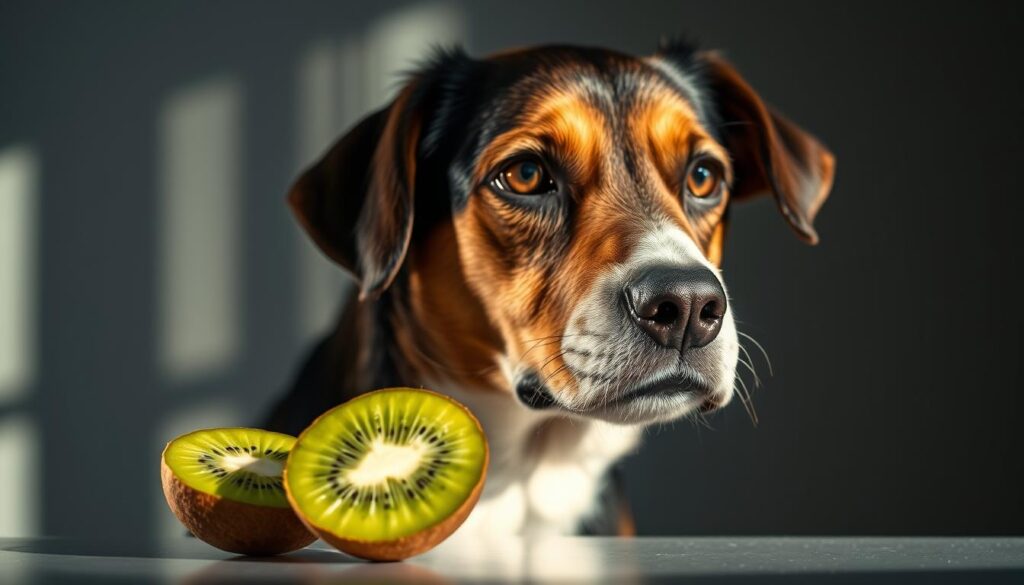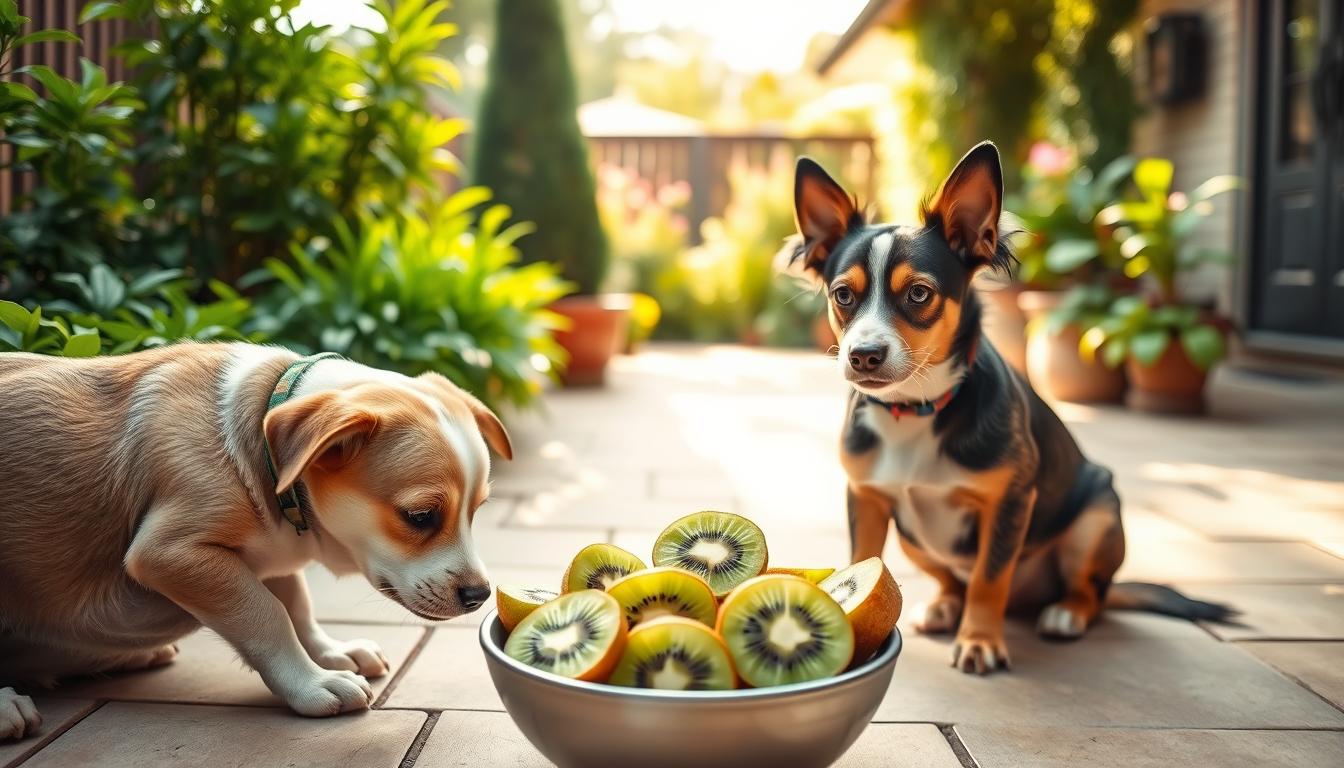Can Dogs Eat Kiwi? What Pet Owners Should Know
Every dog owner wants to share special treats with their furry friend. But, it’s important to know which foods are safe. Kiwi for dogs is a topic many pet parents are curious about.
Is it safe for dogs to eat kiwi? This question needs careful thought. Kiwi has some good nutrients, but it’s key to introduce it correctly. Our guide will help you understand how to feed kiwi to dogs safely.
Your dog’s health is the most important thing. Knowing what’s safe for them to eat is crucial. We’ll share all you need to know about kiwi for dogs. This way, you can make sure your pet stays happy and healthy.
This article will cover everything about kiwi and dogs. You’ll learn about its benefits and risks. Whether you’re thinking about treats or want to add more nutrients to your dog’s diet, you’ll find helpful information here.
Table of Contents
The Safety of Kiwi for Dogs: An Overview
Many pet owners are curious about the safety of kiwi for dogs. They want to know if it’s safe and if it has any benefits. It’s important to think about how it’s prepared, how much to give, and your dog’s health.
Dogs can have kiwi as a special treat if it’s prepared right. Kiwi is full of nutrients that can help your dog stay healthy. But, it’s important to give it in small amounts.
Understanding Kiwi’s Role in Canine Diet
Kiwi isn’t a main food for dogs, but it can be a good addition. It has vitamins and minerals that can help your dog:
- Vitamin C for immune system support
- Dietary fiber for digestive health
- Potassium for muscle and nerve function
Basic Safety Guidelines for Feeding Kiwi
Yes, kiwi is safe for dogs, but you need to follow some steps:
- Remove the fuzzy skin completely
- Cut fruit into small, bite-sized pieces
- Introduce in tiny amounts initially
- Watch for any allergic reactions
When to Avoid Giving Kiwi to Dogs
Some dogs might not do well with kiwi. Don’t give it to dogs with:
- Sensitive stomachs
- Known fruit allergies
- Diabetes or sugar restrictions
Always talk to your vet before adding new foods to your dog’s diet to make sure it’s safe.
Nutritional Benefits of Kiwi for Dogs
Kiwi is a superfood for dogs, packed with nutrients. These small fruits are full of vitamins and minerals that help keep your dog healthy. They offer more than just a tasty treat, supporting your dog’s overall well-being.
Kiwi is a great addition to your dog’s diet now and then. Here’s what makes it so good:
- Vitamin C: Boosts immune system function
- Fiber: Supports digestive health
- Potassium: Promotes muscle and heart health
- Antioxidants: Helps fight cellular damage
When thinking about can puppies eat kiwi, vets say to be careful. Young dogs’ stomachs are sensitive, so start with small amounts. Puppies can enjoy kiwi in moderation after weaning, but check with your vet first.
Kiwi’s antioxidants are great for your dog’s skin and coat. They protect cells and boost overall health. But remember, kiwi should be a treat, not the main part of their diet.
Always introduce new foods gradually and watch for any adverse reactions in your dog.
Can Dogs Eat Kiwi: Guidelines for Safe Consumption
Adding kiwi to your dog’s diet needs careful thought and clear rules. Kiwi can be a tasty treat for dogs if done right. It ensures they get to enjoy this healthy fruit safely.
When making kiwi treats for pets, owners must follow certain tips. This keeps their dog healthy and avoids any stomach problems.
Proper Serving Sizes
The right amount of kiwi for your dog depends on their size and weight. Here are some basic guidelines:
- Small dogs: 1-2 small pieces per serving
- Medium dogs: 2-3 small pieces per serving
- Large dogs: 3-4 small pieces per serving
Preparation Methods
It’s important to prepare kiwi safely for dogs. Follow these steps:
- Wash the kiwi well
- Take off the fuzzy skin completely
- Cut into small, easy-to-eat pieces
- Remove any seeds to stop choking
Feeding Frequency Recommendations
Kiwi should be a rare treat, not a regular food. Veterinarians suggest giving kiwi treats:
- Once or twice a week
- No more than 10% of your dog’s daily calories
- Always introduce new foods slowly
Remember, every dog is different. Always talk to your vet before adding new foods to your dog’s diet.
Potential Risks and Health Concerns

When thinking about kiwi for dogs, pet owners need to know the risks. Kiwi can be good for them, but it’s not without dangers. It’s important to give dogs fruit carefully and in small amounts.
There are a few main risks to consider when giving kiwi to your dog:
- Digestive Upset: High fiber can cause gastrointestinal discomfort
- Choking Hazard: If not prepared right, it can block their airway
- Allergic Reactions: Some dogs might have unexpected sensitivities
Feeding too much kiwi can lead to big problems. Every dog is different, so start with a little bit. Watch how they react.
Look out for these signs after giving kiwi:
- Vomiting
- Diarrhea
- Abdominal pain
- Reduced appetite
It’s best to talk to a vet before adding new foods to your dog’s diet. Kiwi affects dogs differently, so keep an eye on how they do.
Always put your dog’s health first when trying new fruits.
How to Prepare Kiwi for Your Dog
Adding kiwi to your dog’s diet needs careful steps. It’s important to know how to serve kiwi safely. This is key for pet owners who want to give this healthy treat to their dogs.
Step-by-Step Preparation Guide
When thinking about can dogs eat kiwi, preparation is crucial. Follow these steps for safe eating:
- Wash the kiwi under cool running water
- Remove the fuzzy outer skin completely
- Cut the kiwi into small, bite-sized pieces
- Remove any seeds to prevent choking hazards
Safe Serving Suggestions
Start by introducing kiwi slowly to your dog’s diet. Here are some fun ways to serve it:
- Freeze small kiwi chunks as a refreshing summer treat
- Mix tiny pieces with your dog’s regular food
- Use as an occasional low-calorie reward
Storage Tips
| Storage Method | Duration | Best Practices |
|---|---|---|
| Refrigeration | 3-5 days | Store in airtight container |
| Freezing | 2-3 months | Cut into small pieces before freezing |
| Room Temperature | 1-2 days | Keep away from direct sunlight |
Pro tip: Always introduce new foods in small quantities and watch for any adverse reactions.
Signs of Kiwi Allergies or Intolerance in Dogs

When you add kiwi to your dog’s diet, keep an eye out for allergic reactions. Not every dog reacts the same way to new foods, and kiwi is no different.
Spotting allergic symptoms early can help avoid serious health issues. Look out for these important signs:
- Persistent scratching or skin irritation
- Sudden digestive issues
- Swelling around the face or mouth
- Unusual lethargy
- Vomiting or diarrhea
Dogs can react differently to kiwi. Some might just feel a bit off, while others could have a big reaction. How a dog reacts can really vary.
| Symptom Category | Severity Level | Recommended Action |
|---|---|---|
| Mild Skin Irritation | Low | Monitor and reduce kiwi intake |
| Digestive Upset | Medium | Stop feeding kiwi, consult veterinarian |
| Severe Allergic Reaction | High | Immediate veterinary emergency |
If your dog shows any concerning symptoms after eating kiwi, stop giving it to them right away. Call your vet. Always start with small amounts of new foods to avoid risks.
Kiwi Skin and Seeds: What to Know
When looking into kiwi dog treats, pet owners often ask about safety. It’s key to know about kiwi skin and seeds for safe dog feeding.
Not all kiwi parts are safe for dogs. While dogs can eat kiwi, some parts need extra care.
Navigating Kiwi Skin Challenges
Kiwi skin is a challenge for dogs. It’s tough and has a lot of fiber that’s hard to digest. This can lead to:
- Digestive discomfort
- Potential gastrointestinal blockage
- Increased risk of stomach upset
“Always remove the kiwi skin before offering this fruit to your dog.” – Veterinary Nutrition Experts
Seed Safety Insights
Kiwi seeds are generally safe for dogs. Small dogs might face a slight choking hazard, so be extra careful.
For safe kiwi dog treats, follow these steps:
- Completely remove the skin
- Check and remove seeds for small breeds
- Cut fruit into small, manageable pieces
- Introduce in minimal quantities
Knowing these tips helps you add kiwi safely to your dog’s diet, reducing risks.
Different Types of Kiwi and Their Effects on Dogs
Exploring kiwi for dogs means knowing the different types. Green and golden kiwis have unique nutrients that can help your dog. But, they must be prepared right.
Green kiwis are safe for dogs and full of vitamin C. They also have lots of dietary fiber. Can puppies eat kiwi from this variety? Yes, but only a little and with the right prep.
- Green Kiwi Characteristics:
- High in vitamin C
- Good fiber content
- Soft texture when ripe
- Golden Kiwi Considerations:
- Sweeter flavor
- Slightly lower acid content
- Softer flesh
Golden kiwis taste milder and might be more appealing to dogs. Their lower acid content is easier on your dog’s stomach. But, always take off the skin and seeds before giving it to them.
Every dog is different, so watch how they react to kiwi. Start with a small amount and look for any bad signs. If you’re worried, talk to your vet about adding kiwi to your dog’s diet.
Incorporating Kiwi into Your Dog’s Diet
Adding kiwi to your dog’s diet needs careful planning and moderation. It can be a fun way to boost their nutrition. But remember, kiwi should only be a treat, not their main food.
Vets say to start with small amounts of kiwi. This helps your dog get used to it and avoids any stomach problems.
Creative Serving Ideas
- Dice kiwi into tiny bite-sized pieces as a training reward
- Blend kiwi with plain yogurt for a refreshing summer treat
- Freeze kiwi chunks for a cooling snack during hot days
- Mix small amounts of kiwi with your dog’s regular meal as a flavor enhancer
Balanced Diet Considerations
Kiwi is great for dogs, but it should not make up more than 10% of their daily calories. It’s packed with vitamin C, potassium, and fiber. But these should be added to their regular dog food.
“Treats like kiwi are a bonus, not a replacement for balanced nutrition” – Veterinary Nutrition Experts
Before changing your dog’s diet, talk to your vet. They can help figure out if kiwi is right for your dog. This depends on their health, age, and any medical conditions they might have.
Conclusion
Exploring if dogs can eat kiwi shows it’s not just a yes or no answer. It’s about how you introduce it and how much you give. Kiwi can be a fun treat for dogs, but it’s not a main part of their diet.
Before giving kiwi to your dog, make sure to remove the skin and seeds. Cut it into small pieces. Your vet can help decide if kiwi is right for your dog, based on their health and diet needs. Be careful of any signs of allergy or upset stomach when trying kiwi for the first time.
Being a good pet owner means knowing what’s best for your dog’s diet. Kiwi might be good for them, but it should not be the only thing they eat. Always think about your dog’s health and happiness when trying new foods.
Every dog is different, so what’s good for one might not be for another. Being patient and watching your dog closely is key. Also, always get advice from your vet to make sure you’re making the right food choices for your dog.







